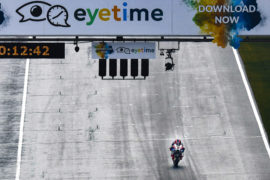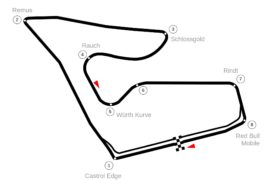If the 2017 MotoGP season has been anything, it has been entirely unpredictable. After two races, we were declaring the season over, and penciling Maverick Viñales’ name on the trophy.
A race later, and we were conceding that Valentino Rossi had taken over the lead of the championship, and that meant that whoever won the title would be riding a Yamaha.
After four races the top four were within ten points, and we gave up on there being a favorite, only to change our minds again after Le Mans, where Valentino Rossi crashed out trying to beat his teammate, and Viñales took a 17-point lead again.
After Mugello, when Andrea Dovizioso won his first dry MotoGP race, Viñales led by 26 points, and was ahead of reigning champion Marc Márquez by 37 points. We had our favorite once again.
Three races and two changes in the championship lead later, and we have given up again. The top four are back within ten points of each other again, and making predictions is looking increasingly foolish.
There was one certainty we could cling to, and would not allow ourselves to let go: At the Sachsenring, Marc Márquez takes pole, and then goes on to win the race.
It has happened the last seven years Márquez has raced at the Sachsenring, from 125s to Moto2 to MotoGP. Surely he would repeat that again? Surely, Marc Márquez would break the unpredictability of MotoGP in 2017?
Keeping It Random
Free practice brought uncertainty once again. Andrea Dovizioso and Maverick Viñales looked formidable in the dry, though both Márquez and his Repsol Honda teammate Dani Pedrosa were not far behind.
In the wet, the Hondas were stronger, the conditions seeming to suit them, though there was the Ducati of Danilo Petrucci, Aleix Espargaro on the Aprilia, and Jonas Folger and Johann Zarco on the Tech 3 Yamahas. Marc Márquez’s domination was far from a foregone conclusion.
Predictability was back after qualifying. In weird mixed conditions, Marc Márquez imposed his will on the field in Q2, pushing ahead of Danilo Petrucci to take pole position. Eight races, eight poles.
It looked like the young Spaniard had everything back on track at the Sachsenring again. But could he convert that into a win, just as he had done seven times before?
Moto3 Gets Mir and Mighty
The support classes promised a return to normality. The Moto3 class turned into a war of attrition at the Sachsenring, as the long string of left-handers took its toll on tires, opening gaps and slimming down the field.
A group of five riders got a gap early, the field breaking when Aron Canet could not follow the pace of Joan Mir, Romano Fenati, Marcos Ramirez, Nicolo Bulega, and Toni Arbolino.
Fenati had chosen the M tire instead of the H, gambling that he could make the softer rubber last and use the extra grip of the tire. It paid off in the beginning, but he once again failed to drive his advantage home.
Mir timed his attack to perfection, striking at the bottom of the hill into Turn 12, beating Fenati on the brakes and taking over the lead. Mir rode a superb race, and with Canet crashing out, takes a comfortable 37-point championship lead into the summer break.
Fenati was forced to settle for second, but he did so gladly. Entirely delighted was Marcos Ramirez, who finally scored the podium he has been so close to several times this season.
Two fourth places at Le Mans and Jerez, and battling in the leading group at Mugello, Barcelona, and Assen, it was clear a podium was coming for the Spaniard. The Platinum Bay Real Estate squad finally got their so coveted podium trophy at the Sachsenring.
A Comedy of Errors
If a small group battling for the win was par for the course for the Moto3 class in Germany, a duel for victory between two riders was much as in previous years in Moto2. It took a while for that duel to unfold, however.
The three championship favorites got away at the start, Marc VDS teammates Franco Morbidelli and Alex Márquez being joined by Interwetten’s Tom Luthi. Márquez highsided himself out of the race first, Luthi crashing six laps later.
That left Morbidelli leading the race on his own. But the race was not over by a long way: as the Italian’s pace started to flag a little, Miguel Oliveira stepped up his and started taking chunks out of the Marc VDS rider.
In the space of five laps, the KTM rider had made up two seconds, and was sitting on Morbidelli’s tail. Oliveira was clearly sizing up the Italian for a pass, but never quite made it stick. This was deliberate, he told the press conference, deciding to wait until the latter stages of the race.
That would prove to be a mistake, but only one he would realize when he tried to pass Morbidelli. Try as he might, he struggled to get past on the brakes, before finally diving through at Turn 12 on the penultimate lap.
His lead lasted just two corners, Morbidelli getting the bike stopped into Turn 1 after passing Oliveira again, then going on to take victory. It was a mature win from Morbidelli, and his sixth of the season, giving him a 37-point lead in the championship.
Oliveira was disappointed, but accepted defeat as a result of the setup choice he had made. Behind Oliveira, Pecco Bagnaia crossed the line in third, taking his third podium in the first nine races of his rookie Moto2 season.
Bagnaia is proving to be a remarkable talent, and his result in Germany merely underlines that impression further.
Setup Compromises
Oliveira’s fourth podium (at the Sachsenring, he was handed third in Barcelona, after Mattia Pasini was disqualified for using oil which contravened the mandatory specifications) is confirmation that the KTM is a competitive package. But watching the race, you were left with the impression that braking was the weak point of the KTM Moto2 bike.
When I asked Brad Binder about that, he said it was the opposite. “I feel like the KTM is stronger on the brakes than the Kalex.”
After the press conference, Miguel Oliveira explained that being beaten on the brakes by Morbidelli was down to a setup choice he made, not to the specific nature of the KTM.
Turn 12 was at the bottom of the hill, Oliveira explained, and just before the turn, the track flattens out. “You can reach the bottom of the suspension really easily, and it’s easy to lose the front.”
If you fix this by stiffening the suspension, then you sacrifice some turning, losing ground through the many long corners which litter the circuit.
“If you want to have turning here, you have to sacrifice a little bit the braking stability,” Oliveira said. “But it’s a very thin compromise, so in the fast part I can’t overtake him, and in the braking, he made the difference.”
Hometown Hero
After normal (for the Sachsenring) Moto2 and Moto3 races, would the pattern continue in MotoGP? When Marc Márquez got the holeshot, it certainly seemed that way. Dani Pedrosa followed, a little slow off the line but getting excellent drive to compensate.
Jorge Lorenzo sat in third, his confidence boosted by finding some grip in morning warm up. But Lorenzo would not be a permanent fixture at the front, the Ducati rider capable of putting in a couple of fast laps to stay with the Repsol Hondas, before his tire started dropping and he started to lose time, and with it, places.
As Lorenzo’s pace slowed, Jonas Folger’s improved, the Monster Tech 3 Yamaha rider capable not only of staying with the Repsol Hondas, but of passing them and challenging for the lead.
He disposed of Pedrosa on lap five, then Márquez the following lap, provoking an almighty roar from the crowd. It has been a while since there was a German rider challenging for the podium at the Sachsenring, let alone actually leading the MotoGP race.
So long, in fact, that it left even Márquez and Pedrosa confused. “On maybe lap four or five Jonas passed me and I was like, hmm?” Pedrosa told the press conference. Márquez was even more surprised when the Tech 3 man came past.
“When we start the race I was just there, trying to control, trying to save the tires, but then Jonas overtook me,” he said. “In the beginning, honestly it was a great surprise because I say, okay, one more rider that can be between me and the others. But then after the laps start to be like, no, what are you doing here? Always very close, never drop. I was pushing a little bit more, little bit more, but he was just there.”
Stepping Out of the Shadow
When Folger took the lead, there were many who believed his pace would not last. Folger would be no match for the experience and speed of Márquez.
They turned out to be wrong: not only did Folger push Márquez nearly all the way to the finish line, but he had the Repsol Honda rider genuinely concerned up to the final laps.
“The last five laps I gave everything,” Márquez told the press conference. “It was not a good idea to arrive in the last lap, last corner with a German rider in the German circuit.”
That final push put clear air between Márquez and Folger. It was to his credit that he did not try to ride over his capabilities to try to stay with Márquez.
The German had already spent the entire race at a positively scorching pace, breaking the lap record into the bargain, but he had also maintained that pace and matched Márquez for 27 laps.
He had learned from sitting behind Márquez and understood a great many things that may help him in the future. “At the end, I let Marc go,” Folger told the press conference. “He has the most experience. I try to stay behind him. To be honest, I learned many things behind him.”
It was a deeply impressive performance by Jonas Folger. The German has been overshadowed so far this season by the astonishing achievements of his Tech 3 teammate Johann Zarco. Unjustly, as Folger’s season so far has been very impressive.
In any other year, the press would be raving about the achievements of Folger. Unfortunately, while Folger has been surprisingly strong, Zarco has been out of this world. At the Sachsenring, those roles were reversed.
That is not to denigrate the achievement of Johann Zarco. The Frenchman made a mistake in FP3 which left him out of Q2, and he did not make it through that qualifying session. That left him nineteenth on the grid, and with a lot of work to do.
But Zarco worked his way forward, eventually making up ten places on a track that is notoriously difficult to pass on, and finishing ninth. On its own, that performance is worthy of note. But at the Sachsenring, he had his teammate to contend with.
Championship Changes
Where has the strong performance of the two Monster Tech 3 Yamaha riders come front? At Barcelona last year, team boss Hervé Poncharal lamented his lot, saying that riders only wanted to sign with factory teams, and rookies were no longer interested in joining a satellite squad.
Yet here Poncharal is, with the two strongest rookies on the grid, and a pair of podiums to their name.
For Poncharal, it was clear that the team owed a great deal of its success to the changes in the technical and sporting rules over the past decade or so. “This wouldn’t be possible without the changes we made to the championship,” he said.
“A lot of people laughed at the CRT, but the CRT and Open bikes helped us get where we are. We have a good bike now, but all the bikes on the grid are good now.”
That ‘good bike’ once again finished ahead of the two factory machines. Is the 2016 Yamaha M1 (at the Valencia test, Yamaha wheel the factory bikes out of the Movistar garage and into Tech 3) a superior product to the bikes from last year? Maybe.
When asked whether the factory Yamaha team should switch back to the 2016 bikes, Folger answered vaguely, but instructively.
“I don’t know exactly what they were trying,” he clarified,” but it looks like they are going to the direction backwards, like 2016. But I’m not sure. They are struggling. We can see they are struggling.”
Backwards Chassis
Calling the new chassis which Valentino Rossi and Maverick Viñales tested at Barcelona, and raced at Assen and the Sachsenring a step ‘backwards’ is an interesting choice of words.
Rumors – some very well informed – persist that the ‘new’ chassis the two Yamaha riders are using is actually the 2016 frame. Even if it isn’t, it certainly resembles the chassis used by the factory riders last year.
It at least helped. Rossi fought his way forward from ninth on the grid to finish fifth, bested by his teammate Viñales who went from eleventh to fourth. Both riders had strong pace, and both were a lot more competitive than they feared they would be.
A relaxed and upbeat Viñales came to talk to the press, looking more cheerful than he has been for at least several weeks.
“I was happy I could recover a lot of positions,” Viñales said. “I made a good start and I’ve learned how to pass! We have to look at the positives and the bike was working quite well during the race. I lost a lot of time with all the other riders but it was a good race and I could do a lot of ‘21s. We still need to improve.”
His pace would have been good enough to follow Márquez and Folger in the race, but he too would have had to let them go at some point. “Being realistic today the best we could have done was P3, Jonas was also very strong,” he said.
Viñales’ improvement had come from a different approach to the electronics, but the Spaniard insisted there is still an awful lot of work still to be done. Viñales called for a return to the approach which had worked for them in the early part of the year.
“We have to make the bike work like it was before,” Viñales said. “Somehow in the races where we are struggling we modified the electronics and we reduced the power every race and now it looks like we need more power from the electronics!”
“At some races we get very confused and we didn’t keep the same line of the electronics during the season and changed it a lot. I hope Michelin can bring the same tires for many races and we can work really hard on the electronics, also today we were not 100% on the electronics, so we need to work and get the confidence with the tires and with the bike as we had in the beginning of the season.”
Not quite there
Viñales’ teammate had resigned himself to a fifth place finish. “Usually I’m not happy with fifth place, because I want to try to fight for the podium every week,” Rossi said.
“But after the weekend, the result is not so bad. Especially for the race that we do, because the race was very difficult, very tough, from the beginning to the end, always pushing to the maximum with somebody 0.0 behind. We are struggling a lot – we were also a little bit unlucky because during practice I broke the good bike two times.”
Without the practice problems, Rossi felt he could have been a little further forward. He may not have had the pace of Márquez and Folger, but he would have at least been in the hunt for the podium. But at least the new chassis works how he wants it to.
“Unfortunately we have just one chassis, so also for the work was a problem. But we were lucky it was dry, because I think in the wet we were struggling more. But fortunately was not like Jerez and Barcelona. We are able to work better on the bike and especially with the new chassis we can be more competitive and had a good pace, from the beginning to the end.”
The factory Yamaha riders had lost out to the factory Hondas, however. Marc Márquez had once again proved indomitable at the Sachsenring, restoring some sense of order to the world of MotoGP.
For eight years in a row, Márquez has converted pole position into victory at the Sachsenring, his 31st premier class win and his 57th over all three classes. In MotoGP, his win tally stands at 31 from 81 starts, or just over 38%.
Leader of the Pack
It also restores Márquez to the head of the championship, something he had not expected just a few races ago. Before Assen, his friend and crew chief Santi Hernandez had sent him a message via WhatsApp telling him he would be leading the championship when the summer break started.
Márquez trailed Maverick Viñales by 23 points at that point in time, so he was far from convinced. “I said, okay, what did you drink? Because we were very far,” Márquez said.
On a touching note, Márquez dedicated the win to Nicky Hayden and his family, after Hayden sadly died just over a month ago. “Something special that I promised to myself, the first victory after Hayden’s accident is for him, for all his family, because he was a very good friend.”
A mark that Hayden had touched many lives throughout his career, both young and old.
While Márquez took victory, his teammate finished third, quickly running out of tire after seven or eight laps. He had been following Jonas Folger, and planning a counterattack, when he ran out of grip on the left side of the tire.
“I tried to see where [Folger] was faster, but I can see that I was spinning a lot suddenly from very good grip to suddenly not so much grip,” Pedrosa said. “So, I said don’t worry. It’s a long race and in this racetrack you normally spin a lot, but you are able still with the spinning to manage, to do a good lap time.”
“But no, every lap I was losing more and more with them because they were going very fast. So, I couldn’t manage to be faster like in practice and I understood at this moment I had to settle for this position.”
One that felt different
Pedrosa was not the only one to suffer such issues. Jack Miller, Danilo Petrucci, and Tito Rabat all reported similar problems. For Miller it left him very disappointed to finish in just fifteenth. Petrucci, too, was mystified, and frustrated at seeing a front-row start turn into a race-long slide into twelfth.
“We had a program to switch maps every ten laps, and at the middle of the race, change the map of the engine brake,” Petrucci said.
“But it was not useful, because the bike after six or seven laps, became very difficult to open the throttle, everybody passed me on the straight, and it’s quite strange to pass a Ducati on the straight. And especially Suzuki, Yamaha, KTM also. Pol passed me when I was in fourth gear.”
Miller tried explicitly not to lay the blame on the Michelins. It was not a bad tire, he emphasized, but rather, “a tire that felt different,” he said.
“It didn’t feel correct. Mainly on the left hand side, from five or six laps, from Turn 5, 6, 7, all the way up the hill on that left hand side, even on partial throttle or shut off, it just kept on coming round on me. I was just trying to keep the bike kind of neutral and calm the whole way through there. I was really fast in the back sector and the bottom of the hill.”
Is this another sign of quality control issues with Michelin? It is hard to say. Dani Pedrosa may have had a problem with this tires, but that did not stop him from finishing third, just eleven seconds off the win. There were plenty of possible culprits which may have contributed.
The track temperatures were hotter than they had been all weekend, and the race was run directly after Moto2 again. The impression that remains is that the Michelins are still sensitive to temperature, and if the temperature is higher or lower than expected, that can have a significant impact on both tire feel and tire performance.
New Ways to Get It Wrong
Cal Crutchlow had a very different tire issue. For him, the problem was one of the front tire being overcooked as he rode in a group. On Saturday, Crutchlow had been adamant that he would race the hard front, but he backed out at the last-minute and went with the medium tire.
That had caused the tire temperatures to rise, which had in turn raised tire pressures, eventually triggering a warning light on the dashboard. Crutchlow had responded by backing off and allowing the tires to cool down a little, before trying to push again and get involved in a battle.
Speaking of dashboard messages, Hector Barbera received warning of a ride-through via his dashboard. Unfortunately, Barbera didn’t look at his dashboard, and did not come in time.
A few laps later, a new message appeared, this time informing the Spaniard that he had been black-flagged. The riders may receive the messages, but it is still clearly up to them to respond to them.
And so the summer break arrives, with four riders within ten points, and Dani Pedrosa just 26 points from the leader, Maverick Viñales. Marc Márquez may have attempted to restore predictability by taking victory at the Sachsenring, but the championship is still way too close to call.
Anything can happen in the next nine races. And if the evidence of the first nine races is anything to go by, anything will happen in the next nine.
This article was originally published on MotoMatters, and is republished here on Asphalt & Rubber with permission by the author.




